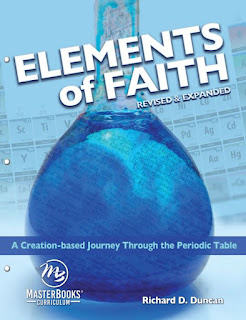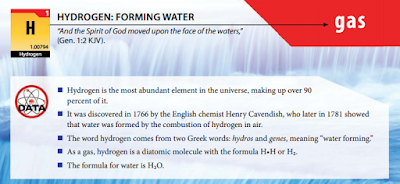Disclosure / Disclaimer: I received this ebook from MasterBooks, free of charge, for review purposes on this blog. No compensation, monetary or in kind, has been received or implied for this post. Nor was I told how to post about it, all opinions are my own
Got a homeschooler who is ahead of their grade level in science,
but you don't want them starting the high school sciences yet?
I've got just the solution for you:
Elements of Faith , from Master Books, examines the 118 current elements of the Periodic Table and
finds meaningful insights and spiritual applications in each of them. A look at the elements can teach many
lessons, from the awesomeness of God’s creation to the dedication of many God-fearing scientists who have
been so influential in the history of science. Each week, students examine three new elements, conduct lab
experiments or additional research assignments, and take a weekly quiz based on that week’s reading. The
arrangement of the Periodic Table is explained, as well as the history of each element and an understanding
of their names and abbreviations.
Review:
Aimed at kids in grades 7-9, this new book goes through all the elements singularly and then looks at them in action-by using them in experiments! It is available in paperback or ebook download.
If there is one thing I really love about MasterBooks, it is their scheduling! It's always well laid out, but offers flexibility- so you can pick which works best for your student, or your (teacher's) needs! For this course, each week studies three new elements.
Days 1-3 are spent on learning the new elements, with some experimentation and research, and then day 4 if for finishing up and review. These days should be about 35 min each we found (lesson plan says 30-45) I love how the elements are not random (as that would drive my OCD child nuts), but by the atomic number, which by the way is color coded to the included Periodic Table of the Elements, at the back of the book! Day 5 is testing, which is done via weekly quizzes and final exam (answer sheets also included for easy teaching!). Grading is on the 10 pt scale. The final exam does include writing in all the elements on the periodic chart!
While Miss Grace likes block scheduling, we found that she could take on 2 elements on 1 day, then on 2nd day due the third and catch up/review. Then take the quiz on Friday.
Each chapter starts with the basic info on the element and its form, then starts in about it. Then there are review questions. What we found worked well was for me to ask Miss Grace those questions BEFORE she read the chapter, to see if she already knew the answers. Then she had an idea of how much she needed to learn, and what might be review. The chapters are SUPER short, so it is doable to finish this course in 1 semester, if your child speeds through it, but it IS set for one whole year, 2 semesters.
There ARE religious sections (applications and My Response) in each chapter, BUT you can choose to skip those if you wanted to. While they do add some depth to the study, they are not intrinsic to it. the included experiments may require adult supervision, but most include items you can easily purchase, and really help your child to understand chemical equations!
While only checking out the first 2 chapters for this review, we decided that she will take it at her own pace next year, and if she finished early, then we will add more chemistry to her course. With being so far ahead, she had finished middle school science already, so I think using this course will really help her in High School biology and chemistry classes, and keep her from being bored! This book is well thought out and is great for kids with quick attention spans. It is easy to bring in more research for each section, and for kids overwhelmed ti almost collegiate science texts, this series may be JUST what they need to enjoy learning about science again and it would be a great resource for kids having trouble in traditional chemistry class, to help them understand the elements better, and we highly recommend it!
About the Author:
Richard D. Duncan is a professional engineer with a Bachelor’s
Degree in Chemical Engineering from the University of Cincinnati.
He has spent most of his career in the fields of water treatment and
environmental engineering.




Comments
Post a Comment